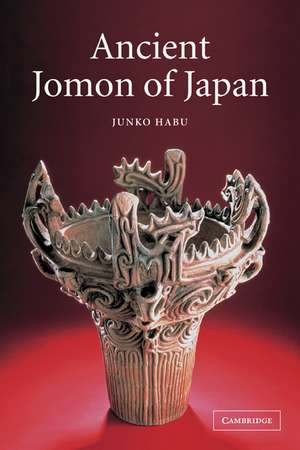Ancient Jomon of Japan: Case Studies in Early Societies, cartea 4
Autor Junko Habuen Limba Engleză Paperback – 28 iul 2004
| Toate formatele și edițiile | Preț | Express |
|---|---|---|
| Paperback (1) | 204.11 lei 3-5 săpt. | |
| Cambridge University Press – 28 iul 2004 | 204.11 lei 3-5 săpt. | |
| Hardback (1) | 577.34 lei 6-8 săpt. | |
| Cambridge University Press – 28 iul 2004 | 577.34 lei 6-8 săpt. |
Preț: 204.11 lei
Nou
Puncte Express: 306
Preț estimativ în valută:
39.06€ • 40.86$ • 32.44£
39.06€ • 40.86$ • 32.44£
Carte disponibilă
Livrare economică 12-26 martie
Preluare comenzi: 021 569.72.76
Specificații
ISBN-13: 9780521776707
ISBN-10: 0521776708
Pagini: 352
Ilustrații: 79 b/w illus. 30 maps 15 tables
Dimensiuni: 165 x 232 x 22 mm
Greutate: 0.56 kg
Ediția:New.
Editura: Cambridge University Press
Colecția Cambridge University Press
Seria Case Studies in Early Societies
Locul publicării:New York, United States
ISBN-10: 0521776708
Pagini: 352
Ilustrații: 79 b/w illus. 30 maps 15 tables
Dimensiuni: 165 x 232 x 22 mm
Greutate: 0.56 kg
Ediția:New.
Editura: Cambridge University Press
Colecția Cambridge University Press
Seria Case Studies in Early Societies
Locul publicării:New York, United States
Cuprins
Part I. Overview: 1. Introduction; 2. Background to the study: overview of the Jomon Period; Part II. Subsistence and Settlement: 3. Subsistence strategies; 4. Settlement archaeology; Part III. Rituals, Crafts and Trade: 5. Mortuary and ceremonial practices; 6. Crafts and exchange networks; Part IV. Discussion and Conclusion: 7. Discussion and conclusion.
Recenzii
'… this book is comprehensive, informative and academically exciting.' Antiquity
'Junko Habu has provided a detailed, comprehensive, and stimulating account of Jomon variety and development … Habu's historical overviews of research trends, syntheses of current results, good grounding in theory, acute observations, and gently stated criticisms have yielded a state-of- the-art book that will serve as the authoritative introduction to the Jomon for a long time to come.' Monumenta Nipponica
'the distinctive aspects covered in this book include the chapters in which Habu presents her original reconstruction of Jomon society based on Anglo-American theories, particularly in relation to the hunter-gatherer models create by Lewis Binford. these chapters make this book a rarity in Japanese archaeology, with the exception of an earlier monograph written by Habu (2001) herslef, and Habu's arguments are important in delineating new hypotheses in Jomon research.' Anthropoligical Science
'The book is comprehensive and covers all aspects of Jomon … Habu's survey not only informs the western reader thoroughly but also offers interesting analogies for comparisons between complex hunter-gatherer societies world-wide.' Journal of Comparative Human Biology
'Junko Habu has provided a detailed, comprehensive, and stimulating account of Jomon variety and development … Habu's historical overviews of research trends, syntheses of current results, good grounding in theory, acute observations, and gently stated criticisms have yielded a state-of- the-art book that will serve as the authoritative introduction to the Jomon for a long time to come.' Monumenta Nipponica
'the distinctive aspects covered in this book include the chapters in which Habu presents her original reconstruction of Jomon society based on Anglo-American theories, particularly in relation to the hunter-gatherer models create by Lewis Binford. these chapters make this book a rarity in Japanese archaeology, with the exception of an earlier monograph written by Habu (2001) herslef, and Habu's arguments are important in delineating new hypotheses in Jomon research.' Anthropoligical Science
'The book is comprehensive and covers all aspects of Jomon … Habu's survey not only informs the western reader thoroughly but also offers interesting analogies for comparisons between complex hunter-gatherer societies world-wide.' Journal of Comparative Human Biology
Notă biografică
Descriere
A 2004 overview of the Jomon period in Japan (circa 14,500–300 BC) within the context of recent complex hunter-gatherer studies.




























